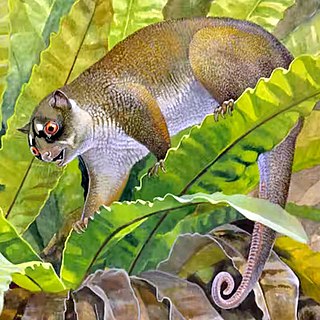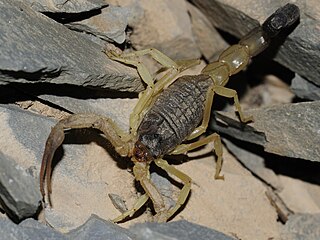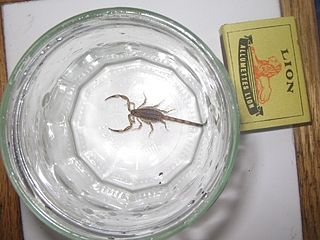
Scorpions are predatory arachnids of the order Scorpiones. They have eight legs and are easily recognized by a pair of grasping pincers and a narrow, segmented tail, often carried in a characteristic forward curve over the back and always ending with a stinger. The evolutionary history of scorpions goes back 435 million years. They mainly live in deserts but have adapted to a wide range of environmental conditions, and can be found on all continents except Antarctica. There are over 2,500 described species, with 22 extant (living) families recognized to date. Their taxonomy is being revised to account for 21st-century genomic studies.

Dibamidae or blind skinks is a family of lizards characterized by their elongated cylindrical body and an apparent lack of limbs. Female dibamids are entirely limbless and the males retain small flap-like hind limbs, which they use to grip their partner during mating. They have a rigidly fused skull, lack pterygoid teeth and external ears. Their eyes are greatly reduced, and covered with a scale.

Diatomyidae is a family of hystricomorph rodents. It is represented by a single living species, Laonastes aenigmamus, native to Laos in Southeast Asia. Fossil species are known from the Oligocene and Miocene of Asia and eastern Europe.

Ektopodon is an extinct genus of marsupial, and is the type genus of the family Ektopodontidae which occurred in forested environments in South Australia, Queensland and Victoria. The last species of this group went extinct in the early Pleistocene. Its body mass was estimated around 1300 grams. Scientists believe that ektopodontids were highly specialised seed-eating possums.

Carcinosomatidae is a family of eurypterids, an extinct group of aquatic arthropods. They were members of the superfamily Carcinosomatoidea, also named after Carcinosoma. Fossils of carcinosomatids have been found in North America, Europe and Asia, the family possibly having achieved a worldwide distribution, and range in age from the Late Ordovician to the Early Devonian. They were among the most marine eurypterids, known almost entirely from marine environments.
The taxonomy of scorpions deals with the classification of this predatory arthropod into 13 extant families and about 1,400 described species and subspecies. In addition, 111 described taxa of extinct scorpions are known.

Hottentotta is a genus of scorpions of the family Buthidae. It is distributed widely across Africa, except for most of the Sahara desert. Species in the genus also occur in the Middle East, the Arabian Peninsula, southeastern Turkey, Iraq, Iran, Afghanistan, Pakistan, India, Nepal, Cape Verde Islands, and Sri Lanka (introduced).

Isometrus is a genus of scorpion belonging and being eponymous to the family Buthidae. Some species are currently assigned to the genus Reddyanus.

The Pseudochactidae are a scorpion family. They are predominantly found in caves.

Vietbocap is a genus of troglobiontic scorpions in the family Pseudochactidae native to South-East Asia.
Alpiscorpius gamma is a species of scorpion found in parts of Central and Southern Europe. Its body reaches the length of 32 mm and is darkly pigmented, but is largely indistinguishable from closely related species with which it forms the »mingrelicus complex«. The animal is not considered aggressive and has mild venom, so it is not dangerous to humans.

Charmus is a genus of buthid scorpions native to India and Sri Lanka.

Reddyanus is a genus of buthid scorpions native to Oriental region from India, Sri Lanka, China: Tibet, to Melanesia. The genus was previously described as a subgenus of Isometrus.
Reddyanus ceylonensis is a species of scorpion in the family Buthidae endemic to Sri Lanka.
Reddyanus jayarathnei is a species of scorpion in the family Buthidae endemic to Sri Lanka.
Reddyanus ranawanai is a species of scorpion in the family Buthidae endemic to Sri Lanka.
Somalibuthus is a genus in the family Buthidae containing the following species:
Aemngvantom is a genus of scorpions belonging to the family Pseudochactidae, first described in 2021 by L. Prendini, V. Ehrenthal, and S. Loria.
Troglokhammouanus is a monotypic genus of scorpions in the family Pseudochactidae, containing the single species Troglokhammouanus steineri. This genus was first described by Wilson R. Lourenço in 2007 based on specimens collected from the Tham Xe Bangfai cave in Khammouane Province, Laos.









